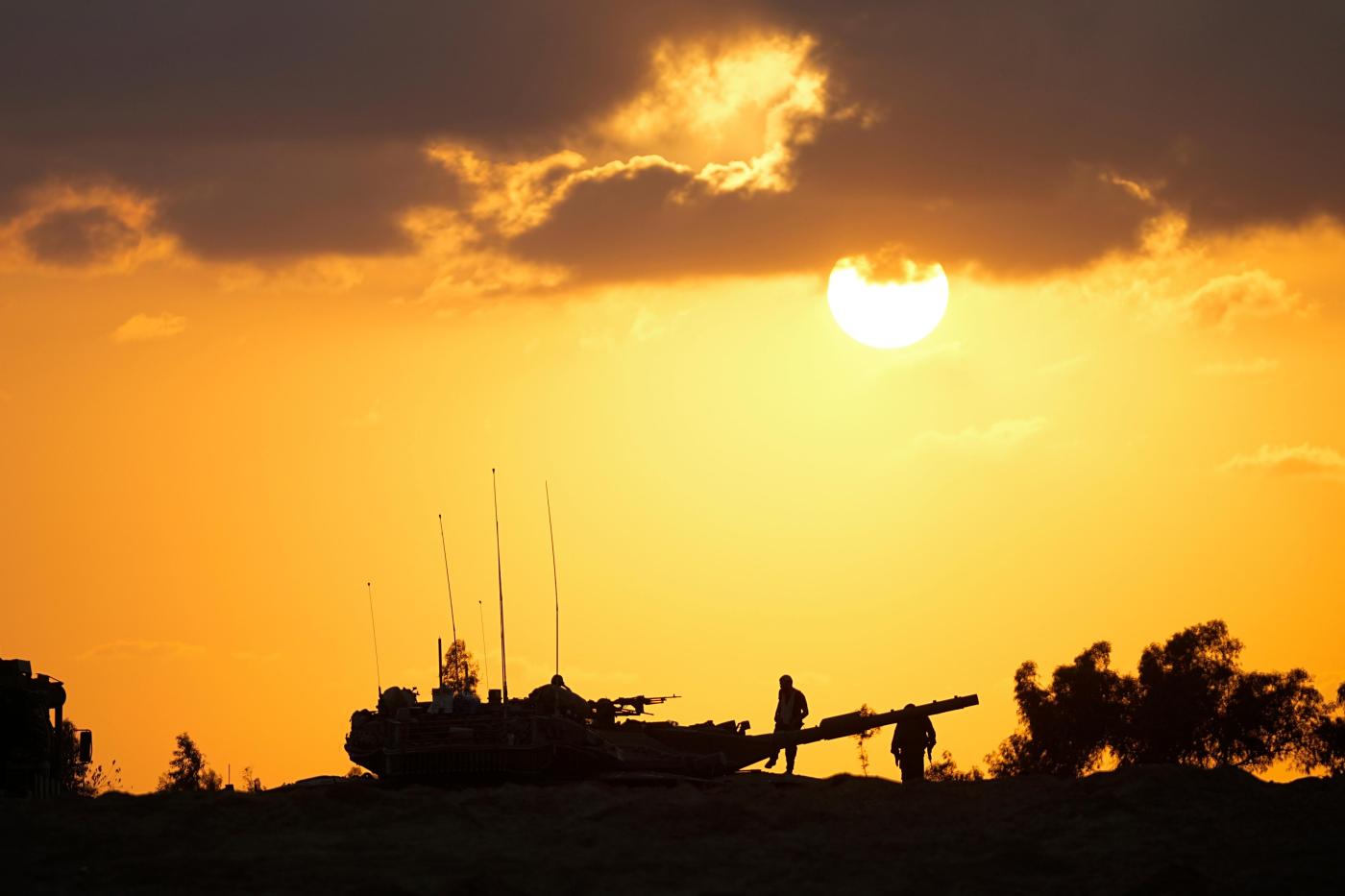
Thomas Friedman: A titanic geopolitical struggle is under way
There are many ways to explain the two biggest conflicts in the world today, but my own shorthand has been that Ukraine wants to join the West and Israel wants to join the Arab East — and Russia, with Iran’s help, is trying to stop the first, and Iran and Hamas are trying to stop the second.
While the two battlefronts may look very different, they actually have a lot in common. They reflect a titanic geopolitical struggle between two opposing networks of nations and nonstate actors over whose values and interests will dominate our post-post-Cold War world — following the relatively stable Pax Americana/globalization era that was ushered in by the fall of the Berlin Wall in 1989 and the collapse of the Soviet bloc, America’s chief Cold War rival.
Yes, this is no ordinary geopolitical moment.
‘Resistance’ vs. ‘Inclusion’
On one side is the Resistance Network, dedicated to preserving closed, autocratic systems where the past buries the future. On the other side is the Inclusion Network, trying to forge more open, connected, pluralizing systems where the future buries the past. Who wins the struggles between these two networks will determine a lot about the dominant character of this post-post-Cold War epoch.
(And in case you’re keeping score at home, China under President Xi Jinping straddles the two networks, along with much of what’s come to be called the global south. Their hearts, and often pocketbooks, are with the Resisters, but their heads are with the Includers.)
Ukraine is trying to break away from the choking Russian sphere of influence to become part of the European Union. Vladimir Putin is trying to block it, because he knows that if Slavic Ukraine — with its vast engineering talent, land army and agricultural breadbasket — joins the European web, his thieving Slavic autocracy will be more isolated and delegitimized than ever. Putin will not be easily defeated, though, especially with the help of arms from his network allies Iran and North Korea and passive support from China, Belarus and many members of the global south hungry for his cheap oil.
Israel was trying to forge a normalized relationship with Saudi Arabia, which is the gateway to the many Arab Middle East states and Muslim states in South Asia with whom Israel still does not have relations. But it’s not only Israelis who wanted to see El Al planes and Israeli technologists landing in Riyadh; Saudi Arabia, under Crown Prince Mohammed bin Salman, itself aspires to become a giant hub of economic relations that would tie Asia, Africa, Europe, the Arab world — and Israel — into a network centered in Saudi Arabia. His vision is a kind of European Union of the Middle East, with Saudi Arabia playing the anchor the way Germany does with the real EU.
Iran and Hamas want to stop this for joint and separate reasons. Jointly, Hamas and Iran knew that if Israel cemented ties with a newly modernizing Saudi Arabia — on top of Israel’s relations with the United Arab Emirates, Morocco and Bahrain under the Abraham Accords — the balance of power between the secularizing, pluralizing, more market-driven network in the region and the more closed-off, anti-pluralizing, political-Islam-inspired network could tip decisively against both Iran and Hamas, isolating them both.
Hamas also does not want to see Israel normalize relations with Saudi Arabia without having to make a single concession to Palestinians in terms of their own aspirations for statehood. Prime Minister Benjamin Netanyahu of Israel believed it would be the crowning achievement of his career — and prove all his critics wrong — if he could seal open diplomatic ties with Saudi Arabia, the home of Islam’s holiest sites, without conceding one iota to the Palestinians. This was a reckless goal — Netanyahu should have offered the Palestinians at least some pathway for greater self-rule, if only to make it all easier for Saudi Arabia to sell at home — and Israel is now paying the price. Saudi Arabia says it is still open to normalizing with Israel, but only if Israel gives a firm commitment now for an eventual two-state solution.
So don’t let anyone tell you that the wars in Ukraine and the Gaza Strip do not matter or are disconnected — or are none of America’s business.
The struggle in Ukraine
These wars very much are our business — and now clearly inescapable, since we’re deeply entwined in both conflicts. What’s crucial to keep in mind about America — as the leader of the Inclusion Network — is that right now, we’re fighting the war in Ukraine on our terms, but we’re fighting the war in the Middle East on Iran’s terms.
How so?
In the Ukraine-Russia war, the Ukrainian army and people are bearing the full brunt of the conflict — and are ready to continue doing so. All they are asking the United States and its allies for are advanced weapons and financial help. How could we possibly be balking? For tens of billions of dollars, and not a single American soldier killed, Ukraine has inflicted a profound setback to Putin’s army that makes it much less dangerous to the West and to Ukraine. It’s the greatest bargain NATO ever got.
CNN recently described, per a source familiar with it, a declassified U.S. intelligence assessment provided to Congress saying that Russia had lost 87% of its pre-invasion active-duty ground troops and two-thirds of its tanks that it had prior to its invasion of Ukraine. Putin can still inflict a lot of damage on Ukraine with missiles, but his dream of occupying the whole country and using it as a launchpad to threaten the Inclusion Network — particularly the NATO-protected EU — is now out of reach. Thank you, Ukraine.
At a breakfast with NATO leaders devoted to the Ukraine issue in Davos, Switzerland, this year, Canada’s deputy prime minister, Chrystia Freeland, noted that it is we, the West, who should be thanking the Ukrainians, not forcing them to beg us for more weapons.
She also eloquently formulated the stakes: “What Putin wants is to transform the world order” that evolved since World War II and the post-Cold War — where “the competition between nations was about who can be richer and who can help their people prosper the most … Putin hates that world because he loses in that world; his system is a loser in a peaceful, global, wealth-enhancing paradigm. And so what he wants is to move us back to dog-eat-dog, to a 19th-century great-power competition, because he thinks he can, if not win, be more effective there … Let’s not think that this is a Ukrainian problem. This is a problem for us all.”
She is exactly right.
The struggle in the Middle East
The struggle in the Middle East has different roots, and fascinating ones: The Resistance Network and the Inclusion Network there were born within two months of each other in 1979.
The Middle East’s Resistance Network came into being Feb. 1, 1979, when Ayatollah Ruhollah Khomeini flew into Tehran, Iran, from Paris, capping an Iranian revolution that ousted the shah and gave birth to the Iranian Islamic Republic that would attempt to export its ideology across the entire Muslim world while also seeking to drive America out of the region and Israel out of existence.
The Middle East’s Inclusion Network was birthed that same year when the U.S. brokered the Egypt-Israel peace treaty, enabling Arab-Israeli collaboration for the first time. Also in 1979, Sheikh Rashid ibn Saeed Al Maktoum — the ruler of the port city of Dubai in the United Arab Emirates — completed Jebel Ali Port, one of the largest in the world, establishing Dubai and the UAE as a global hub that would connect the Arab East — through trade, tourism, services, shipping, investments and world-class airlines — with almost every corner of the planet.
In 2015, this Middle East Inclusion Network got a huge boost with the rise in 2015 of Crown Prince Mohammed — with whom I recently met in Riyadh — and his aspiration to transform Saudi Arabia into a giant Dubai on steroids and make it the cultural, investment, conference, tourism and manufacturing center of a much more integrated region.
Nadim Koteich, a Lebanese Emirati political analyst and general manager of Sky News Arabia, who helped me see the contrast between these two networks struggling to shape the Middle East, explained that the Resistance Network “is orchestrated by Iran, Islamists and jihadists” in a process they refer to as the “unity of battlefields.” This network, he noted, “seeks to bridge militias, rejectionists, religious sects and sectarian leaders,” creating an anti-Israel, anti-American, anti-Western axis that can simultaneously pressure Israel in Gaza, in the West Bank and on the Lebanon border — as well as America in the Red Sea, in Syria and in Iraq and Saudi Arabia from all directions.
In stark contrast, Koteich said, stands the Inclusion Network, one that’s focused on “weaving together” global and regional markets instead of battlefronts, business conferences, news organizations, elites, hedge funds, tech incubators and major trade routes. This inclusion network, he added, “transcends traditional boundaries, creating a web of economic and technological interdependence that has the potential to redefine power structures and create new paradigms of regional stability.”
So today, while the U.S. is indirectly degrading Russia’s capabilities, through its proxy Ukraine, things are different in the Middle East. There, it is Iran that is sitting back comfortably — indirectly at war with Israel and America and sometimes Saudi Arabia, by fighting through Iran’s proxies: Hamas in Gaza, the Houthis in Yemen, Hezbollah in Lebanon and Syria and Shiite militias in Iraq.
Iran is reaping all the benefits and paying virtually no cost for the work of its proxies, and the U.S., Israel and their tacit Arab allies have not yet manifested the will or the way to pressure Iran back — without getting into a hot war, which they all want to avoid.
To deter Iran
My own view is that the best way to deter Iran is by enhancing pressures from the inside — where the Inclusion Network has the most allies: Iran’s young people and their aspirations to be part of the Inclusion Network. How do we know? Because many of Iran’s youth, starved for inclusion, have been in open revolt against the regime since September 2022, when a 22-year-old woman, Mahsa Amini, was arrested in Tehran by Iran’s morality police for allegedly wearing her hijab improperly and then died in custody.
A regime under which women die in custody after being arrested for not covering up enough is not a secure or popular regime. Moreover, many educated Iranians know that their regime is just using support for the Palestinian cause as a cover for Iranian imperialism all across the region, where Tehran indirectly controls Syria, Lebanon, Iraq and Yemen. Which is why — remarkably — we keep seeing protesters in Iran popping up to express support for Israel since Hamas’ Oct. 7 attack and against Tehran’s costly imperial adventures. Yes, you read that right.
“During a game between the football clubs Persepolis and Gol Gohar at the country’s national football stadium, operatives of the Iranian Revolutionary Guards Corps attempted to rally support for the Palestinian cause by waving Palestinian flags on the pitch,” the London Jewish Chronicle reported Oct. 9, posting the raw footage from X, formerly known as Twitter. “Instead of sympathy, the Basij — one of the five forces of the I.R.G.C. — was met with chants from fans in the stands to ‘shove that Palestinian flag up your a**!’ Footage of the incident went viral on social media.” It included tweets like, “True Iranians will always support Israel! The Islamic Republic is an occupying force.”
The nonpartisan Stimson Center in Washington published a commentary by an Iran-based analyst in October on Iranian opposition to the Hamas attack, which included an amazing Instagram video posted by a prominent Iranian analyst showing Iranian “college students refusing to walk over the flags of the U.S. and Israel which are often placed at the entrance to universities in Iran as a show of support for the Palestinians.” Meanwhile, The Economist reported about Iranian “baristas in cafes” who “pinned stars of David to their aprons.” This attitude is by no means universal; lots of other Iranians surely side with Hamas, especially with the civilian casualties in Gaza. Nevertheless, noted Iran International, an Iranian opposition channel based in London, “‘No Gaza, No Lebanon, I shall die for Iran,’ has been a recurring slogan in many protests in Iran.”
The Resistance: wasteful wars
The members of the Resistance Network are great at tearing down and breaking stuff, but, unlike the Inclusion Network, they have shown no capacity to build any government or society to which anyone would want to immigrate, let alone emulate. (The visa line to get into Houthi-run Yemen is not long.) We don’t stress that enough.
For all of these reasons, this is a moment of great peril as well as great opportunity — especially for Israel. The competition between the Resistance Network and the Inclusion Network means that the region has never been more hostile or more hospitable to accepting a Jewish state.
It is too bad that a traumatized Israel under Netanyahu’s failed leadership can’t see this right now. If Israel could one day agree to a long-term process with a transformed Palestinian Authority to build two states for two peoples, it could decisively tip the balance between the Resistance Network and the Inclusion Network.
The Resistance Network would have nothing to justify the wasteful wars it fights and the arms it amasses — supposedly to defeat Israel and America but actually to keep its own people down and itself in power. Meanwhile, the Inclusion Network would find it that much easier to widen, to cohere and to win.
As I said, there’s a lot more at stake today than meets the eye.
Thomas Friedman, born in Minneapolis and raised in St. Louis Park, writes for the New York Times.


